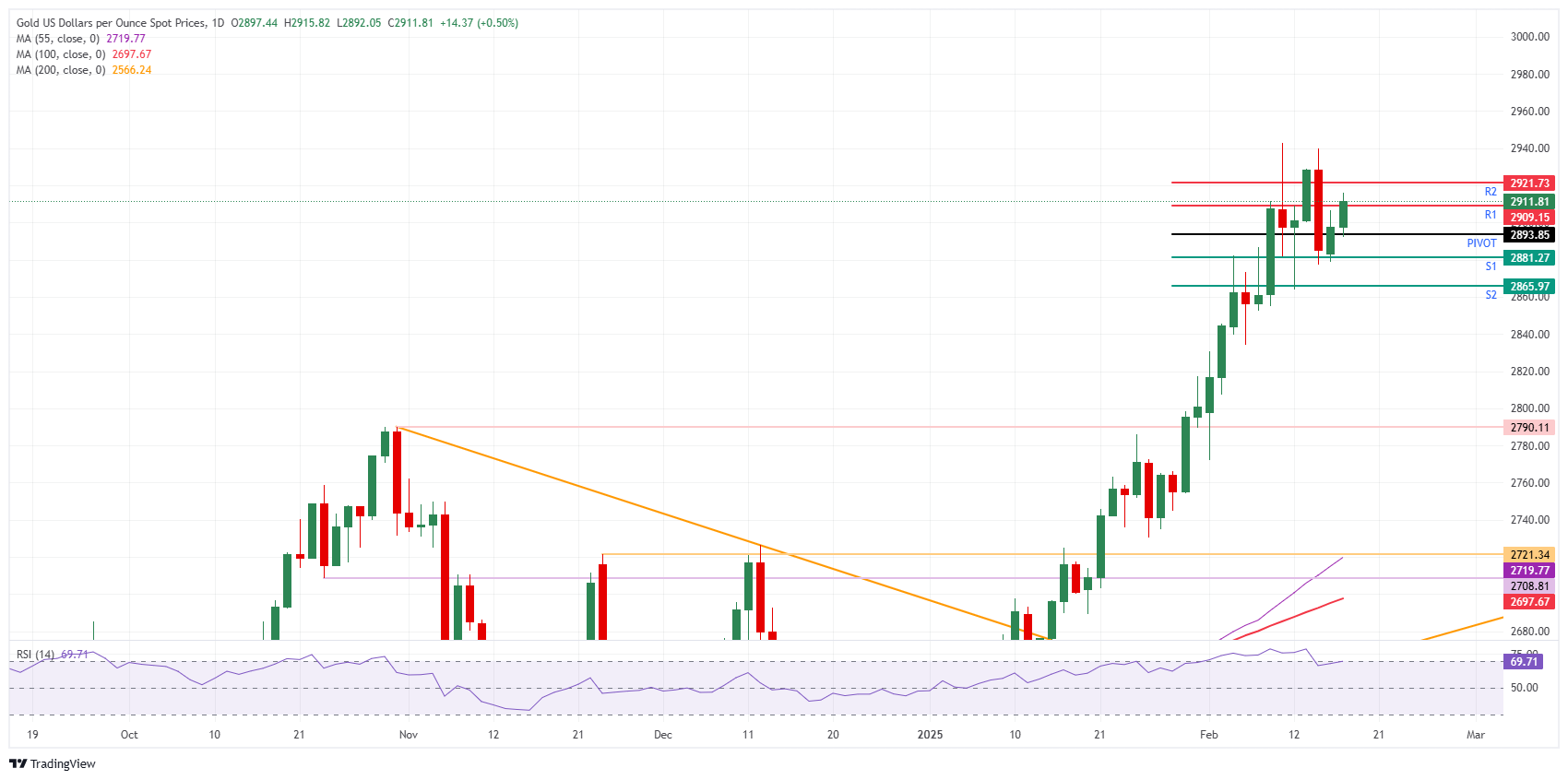Gold in second day of gains with US and Russian officials meeting for peace talks
- Gold sets forth rally and pops above $2,900 at the start of the European trading session on Tuesday.
- Markets brace for headlines to come in from Saudi Arabia where US and Russian officials are meeting.
- A daily close above $2,910 could put Gold on track for a new all-time high this week.
Gold’s price (XAU/USD) is rallying near 0.50% this Tuesday at the start of the European trading session, with the precious metal trading around $2,910 at the time of writing. US yields are catching up on events after the US President’s Day holiday on Monday. Still, Gold is in favor of traders as a safe haven for tariffs and geopolitical uncertainty.
Meanwhile, Federal Reserve Bank (Fed) President of Philadelphia Patrick Harker advocated on Monday night for the central bank to keep interest rates unchanged. He pointed out that recent inflation reports and gauges are not tracking economic changes that are currently taking place. Federal Reserve Bank of San Francisco President Mary Daly and Federal Reserve Vice Chair for Supervision Michael Barr will speak later this Tuesday at 15:20 GMT and 18:00 GMT, respectively.
Daily digest market movers: Geopolitics take over
- Goldman Sachs raised its year-end gold target to $3,100 an ounce due to central bank buying and inflows into bullion-backed exchange-traded funds, Reuters reports.
- Gold shipments from Singapore to the US climbed to the highest level in almost three years in January, a further sign of the ructions in bullion trading after pricing disparities opened up in key markets. Gold shipments from Singapore to the US reached 11 tons in January, up 27% from December, Bloomberg reports.
- The US administration has asked European nations to explain what security guarantees they’re willing to provide to Ukraine as part of a peace deal. The move followed United States (US) President Donald Trump’s push to begin talks with Russian President Vladimir Putin.
- Investors are still analyzing more details of the US reciprocal tariff plans, which could take months to implement due to their complexity. Trump’s trade policies have become increasingly muddled due to delays and exclusions, with concerns about the impact on the global economy aiding bullion’s role as a store of value.
Technical Analysis: RSI at boiling point
Gold is climbing the ladder again this week, that stairway to new all-time highs. However, the Relative Strength Index (RSI) indicator in the daily chart is starting to flash overbought signals again, warning that the price action is overheating. With these elevated levels in RSI, buyers could be reluctant to buy more and wait for the Gold price to cool down to better levels before buying.
After Monday’s not-so-big move, the daily pivots have been reshuffled and are moving closer together. The first support is seen at $2,893, which is the daily Pivot Point. It has already served as support during the Asian trading session. Should this level come under threat again on Tuesday, the S1 support at $2,881 could do its duty.
On the upside, the R1 resistance at $2,909 is being reclaimed at the time of writing. A daily close above this level would be a healthy bullish signal for more upside into Wednesday. The R2 resistance at $2,921 is the next level to be recovered before considering a fresh all-time high, currently at $2,942.

XAU/USD: Daily Chart
Gold FAQs
Gold has played a key role in human’s history as it has been widely used as a store of value and medium of exchange. Currently, apart from its shine and usage for jewelry, the precious metal is widely seen as a safe-haven asset, meaning that it is considered a good investment during turbulent times. Gold is also widely seen as a hedge against inflation and against depreciating currencies as it doesn’t rely on any specific issuer or government.
Central banks are the biggest Gold holders. In their aim to support their currencies in turbulent times, central banks tend to diversify their reserves and buy Gold to improve the perceived strength of the economy and the currency. High Gold reserves can be a source of trust for a country’s solvency. Central banks added 1,136 tonnes of Gold worth around $70 billion to their reserves in 2022, according to data from the World Gold Council. This is the highest yearly purchase since records began. Central banks from emerging economies such as China, India and Turkey are quickly increasing their Gold reserves.
Gold has an inverse correlation with the US Dollar and US Treasuries, which are both major reserve and safe-haven assets. When the Dollar depreciates, Gold tends to rise, enabling investors and central banks to diversify their assets in turbulent times. Gold is also inversely correlated with risk assets. A rally in the stock market tends to weaken Gold price, while sell-offs in riskier markets tend to favor the precious metal.
The price can move due to a wide range of factors. Geopolitical instability or fears of a deep recession can quickly make Gold price escalate due to its safe-haven status. As a yield-less asset, Gold tends to rise with lower interest rates, while higher cost of money usually weighs down on the yellow metal. Still, most moves depend on how the US Dollar (USD) behaves as the asset is priced in dollars (XAU/USD). A strong Dollar tends to keep the price of Gold controlled, whereas a weaker Dollar is likely to push Gold prices up.

